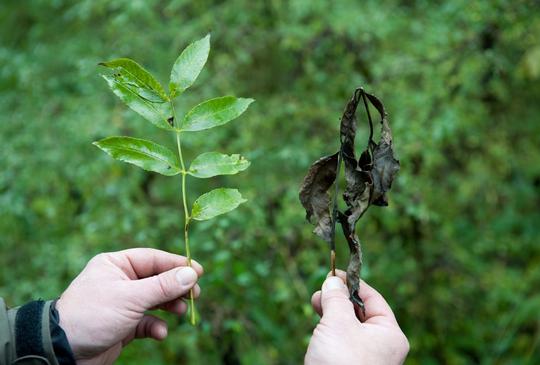
Tackling tree pests and diseases in Greater Manchester: Ash Dieback
Despite already facing great pressure from climate change, pollution and urban development, our trees and woodlands are facing a growing threat from a variety of pests and diseases.
These ailments contribute to the loss of millions of trees and could have a disastrous effect on the environment if the right action isn't taken.
As part of the City of Trees movement, which centres on a commitment to double the tree cover in Greater Manchester, Red Rose Forest is actively campaigning to raise awareness of tree diseases and engage the public on this issue.
The forest specialists have recently developed a Greater Manchester themed information leaflet, which can be found in our document library, on the threat of the most well known UK tree disease, ash dieback.
Ash dieback (also known as Chalara dieback) is a fungal infection that is having a serious impact on ash trees across Britain and is present across northern Greater Manchester.
The disease causes leaf loss, crown dieback and bark lesions in affected trees.
Once a tree is infected, the disease is usually fatal, either directly, or indirectly, by weakening the tree to the point where it is too frail to protect itself against attacks by other pests or pathogens.
Ash dieback is carried via spores and spread by wind locally, and also through the movement of diseased plants.
The Forestry Commission has a useful symptoms page for ash dieback (and many other tree diseases) and we advise you to consult this for more information.

There are approximately 1 million ash trees across Greater Manchester. As well as in woodland plantings, ash is widely found as a street and park tree. It freely regenerates and clumps of young trees are frequently seen on roadside verges and within woods.
Typically, young trees in these locations are often the first to be spotted in an infected area. Most of the woodland plantings in Greater Manchester over the last 15 years contain some element of ash.
The Forestry Commission first reported a more localised outbreak of ash dieback in Greater Manchester in October 2014. At this time, the disease symptoms were quite subtle and not easily spotted.
The arrival of ash dieback in Greater Manchester was sooner than previously predicted and it is thought that the disease will spread throughout the region, becoming more frequent and severe in its expression.
The most recent Forestry Commission map of the disease has picked up fresh outbreaks in Cumbria, near Chapel-en-le-frith and north Wales.
There will be more work (and cost) involved in managing and monitoring our ash trees and woodlands in the future, which is why it’s so important to recognise and report any unusual tree symptoms.
The Internet and social media in particular have made it much easier to identify tree diseases and get expert help.
You can head to the Tree Alert website, a tool developed by the Forestry Commission, to record the location and symptoms of any potentially infected trees.
Similarly, Observatree is a collaborative project with an aim to protect the UK’s trees, woods and forests from harmful pests and diseases.
The project encourages tree health professionals and people actively involved with trees to act as citizen scientists and report potential sightings of tree pests and diseases.
As their website purports, "more eyes on the ground means a greater chance of earlier detection."
Head to their website for more information on spotting and reporting ash dieback.
It’s also important to adopt a mindful approach when tackling any tree pest or disease.
"Even though our ash trees are now exposed to this new threat, tree and woodland owners should not rush to fell them,’ said Andy Long, Woodlands Officer at Red Rose Forest.
"It’s important that wherever possible, trees should be left in order to spot any showing disease tolerance. A balanced approach to retaining deadwood for biodiversity, and health and safety should also be adopted."
In spite of this threat, our woodlands are remarkably resilient and could be made more so, given appropriate management.
Ash trees won’t disappear from our landscape just yet but will face a reduction in their health and numbers over the coming years.
More detailed advice on ash dieback can be found on the Forestry Commission website and in our document library.
Main image credit: Dan Docker /Forestry Commission
Inline image credit: Forestry Commission
Trees in hard landscapes – Getting it right in Greater Manchester
Contributed by Matthew Millett
Contributor Profile
Grace is a writer and editor here at Platform and also works as a Copywriter at Creative Concern.
She graduated from The University of Nottingham in 2013 with a degree in English and Creative Writing and afterwards interned within the editorial department of a number of publications, before securing a position as Assistant Editor at a Manchester based magazine.



